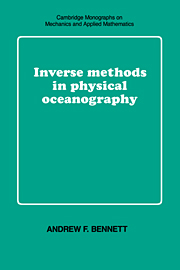Book contents
- Frontmatter
- Contents
- Preface
- 1 Finite-dimensional inverse theory
- 2 The smoothing of observations
- 3 Data assimilation
- 4 The spatial structure of the Kalman filter
- 5 Generalized inverses of dynamical models
- 6 Antenna analysis
- 7 Nonlinear quasi-geostrophic models
- 8 Open-ocean modelling: quasi-geostrophy
- 9 Primitive-equation models
- 10 Outstanding problems
- Bibliography
- Subject index
Preface
Published online by Cambridge University Press: 08 January 2010
- Frontmatter
- Contents
- Preface
- 1 Finite-dimensional inverse theory
- 2 The smoothing of observations
- 3 Data assimilation
- 4 The spatial structure of the Kalman filter
- 5 Generalized inverses of dynamical models
- 6 Antenna analysis
- 7 Nonlinear quasi-geostrophic models
- 8 Open-ocean modelling: quasi-geostrophy
- 9 Primitive-equation models
- 10 Outstanding problems
- Bibliography
- Subject index
Summary
Inverse methods combine oceanic observations with theoretical models of ocean circulation. The methods lead to
estimates of oceanic fields from sparse data, guided by physical laws;
estimates of meteorological forcing fields;
estimates of parameters in the physical laws;
designs for oceanic observing systems;
resolution of mathematically ill-posed modeling problems; and
tests of scientific hypotheses.
The rapid development of inverse methods in physical oceanography over the last decade has been greatly influenced by the work of meteorologists and solid-earth geophysicists; the growing interest of oceanographers in inverse methods is largely in response to the arrival of great volumes of data collected by artificial earth satellites. Collected articles may be found in conference proceedings edited by Anderson & Willebrand (1989), and by Haidvogel & Robinson (1989). Even greater volumes of data are anticipated from planned, future missions. The emergence of inverse theory as a scientific tool has provided a major stimulus to numerical modeling of ocean circulation, which has moved beyond the infancy of thought-experiments but has only tentatively entered the maturity of operational forecasting long occupied by meteorologists. The extraordinary recent gains in computer performance will enable theoretical oceanographers, who have come to inverse theory relatively lately, to consider applying the most elegant and powerful inverse methods to their most complex models. (While this preface was being written, a computer manufacturer announced a 128-gigaflops, 32-gigabyte machine.)
- Type
- Chapter
- Information
- Inverse Methods in Physical Oceanography , pp. viii - xviiiPublisher: Cambridge University PressPrint publication year: 1992



